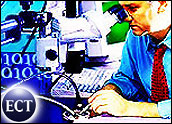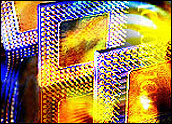
During the late 19th century, shortly after creating the light bulb, Thomas Edison founded the company that eventually became General Electric.
Although the company does not generate the headlines in the computing press that Microsoft, Apple or IBM does, it has been a behind-the-scenes, trend-setting high-tech innovator. Specifically, GE’s technology almost single-handedly defines medical computing, one of the hottest emerging niches in the computer industry today.
“The company continues to invest in research and development, despite economic uncertainties, giving it a distinct competitive advantage toward the future,” Robert Hornsby, a spokesperson for GE, told TechNewsWorld.
“GE is currently investing (US)$100 million in capital improvements alone to its Global Research Center in Niskayuna, New York,” he said. “Additionally, GE’s other R&D centers are expanding, and new centers are opening around the globe.”
Past and Present
Back in 1896, the company developed the first electrical equipment for producing X-rays, building on the discovery of Marie Curie and her husband. In 1962, the company built a superconducting magnet, which led to the development of magnetic resonance imaging — most commonly known today as MRI. During the 1970s, the company built the first computer-based system to analyze electrocardiograms to read patients’ heartbeats.
While many of these technologies have become mainstays at hospitals around the world, the company continues to innovate and introduce new technologies. These technologies, much like the geographic locations of GE’s research labs, match the company’s low-profile posture. For example, the medical systems division — which includes a research lab and manufacturing facility — is far off the beaten path, at least as far as the computer industry is concerned.
Located in Waukesha, Wisconsin, GE’s medical division generates $9 billion in annual sales from computer-related medical technologies and employs 27,500 people to develop and manufacture products for radiology, clinical information systems and clinical communications networks. Clients include major hospitals across the United States and Europe.
Hospital Tech
This summer, the Children’s Hospital of Wisconsin began implementing what its backers describe as one of the most comprehensive, computerized medical records systems in the country. The research hospital is replacing paper-based files with digital ones to keep patients’ records, including medical histories, test results, diagnostic images and related information.
Once the project is complete, a proprietary network will link all of the departments in the hospital, including the emergency room, the surgical rooms, radiology and the pharmacy.
“A fully integrated electronic medical record system will be a tremendous advantage to busy physicians and nurses and a real benefit to our young patients,” Carl Weigle, director of medical information services at Children’s Hospital, told TechNewsWorld.
“When our staff members have access to all necessary documents, images, lab results and orders — available just by entering their user name and password — they will be better able to make treatment decisions.”
Present and Future
In a paper-based system, records are entered in the emergency room upon admission of a patient. These records must be entered again in the main hospital, said Dow Wilson, president and CEO of GE Medical Systems Information Technologies.
However, the new network, in addition to avoiding the repetition required of paper-based systems, will alleviate possible problems associated with writing prescriptions that might conflict with the patient’s current medication. The system will provide the patient’s complete history anywhere in the hospital. Developed by GE, the Picture Archiving Communications System (PACS) is a medical technology specifically designed to store images of all the medical documents in a system. GE will use the hospital as a demonstration site for its capabilities in communications systems.
In addition to PACS, GE’s medical division recently unveiled an advanced magnetic resonance imaging technique — called Excite — to provide better resolution for imaging the body. The technology is being showcased this week at the annual International Society for Magnetic Resonance in Medicine meeting in Toronto, Canada.
GE’s Excite technology is designed to improve diagnoses of diseases by allowing radiologists to see critical areas of MRI scans previously compromised by such things as poor circulation or patient motion. These new technologies will allow patients to complete an MRI in less time than with traditional systems — a feature that is especially important for people who have difficulty remaining motionless for long periods.
Storage Tech
Meanwhile, across the country in Baltimore, Maryland, at the Veterans Affairs Medical Center, GE is installing an online storage area network to increase the speed at which clinicians there can access images in the current database of patient records.
In the 1990s, thanks to GE, the hospital in Baltimore was one of the first sites in the nation to develop a filmless archive of medical images — what has now become known as a digital library — to replace the huge archive of X-rays and other images at the hospital. By the standards at the time, this was a huge amount of content to convert. The hospital generates close to 100,000 radiological procedures annually.
After migrating all the images, the records can now be accessed from any one of 40 clinical workstations, linked by an optic cable to a central server. The enterprise-wide network also connects to hospitals in a 50-mile radius of Baltimore, making the new network a medical-communications superhighway, said Vishal Wanchoo, vice president of imaging systems at GE.
Development Strategy
Researchers from GE also are working closely with hospitals to implement several new innovations in the area of ergonomics to address such factors as lighting and seating. In addition to all of this, GE scientists are collaborating with hospitals to develop tools to allow 3D viewing of large amounts of data, like multiple scans of computerized tomography images.
GE’s tomography technology works by producing 3D images of the internal structures of the human body by recording differences in the effects of the passage of energy waves over those structures.
While GE’s impact might not be noticed on the consumer level — except in the lighting aisle at the local hardware store, where GE has always been present — the company keeps quietly innovating its way into hospitals and medical facilities. Indeed, generating revenues of $131.7 billion last year, the company seems well positioned for the future.
With so many resources and such a long history, the company’s medical division, a major focus of today’s General Electric, could indeed generate one of the next major advances in medical technology. “The vision is to improve patient safety and make health care as efficient and cost effective as possible,” said Wilson.




















































